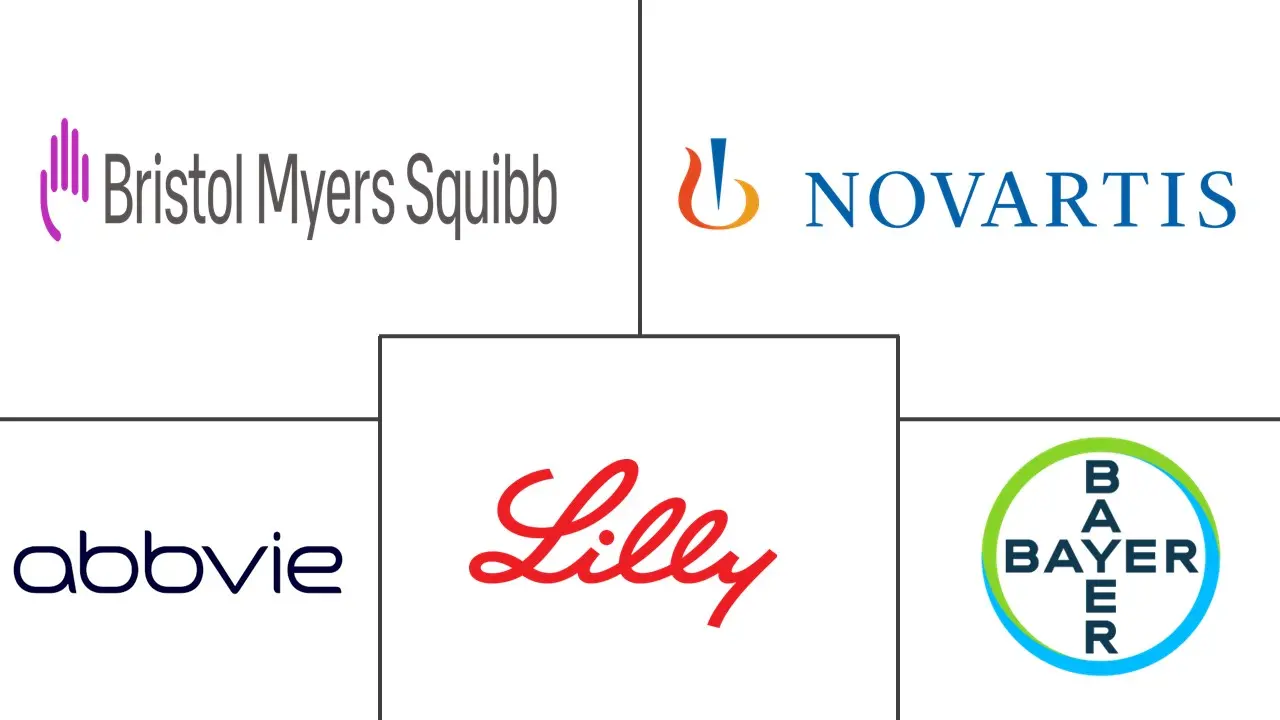Drug Discovery Market Size and Share
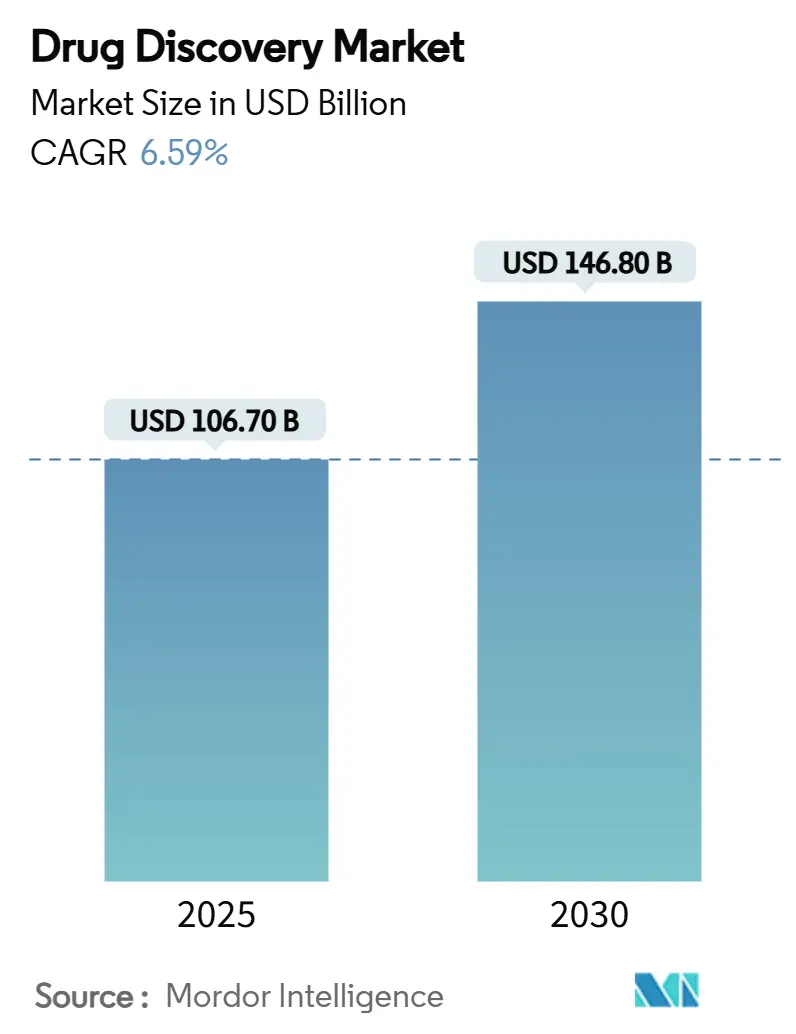
Drug Discovery Market Analysis by Mordor Intelligence
The global drug discovery market size stands at USD 106.70 billion in 2025 and is forecast to reach USD 146.80 billion by 2030, expanding at a 6.59% CAGR. Growth is propelled by rising chronic disease prevalence, sustained R&D spending, and the accelerating adoption of artificial intelligence across discovery workflows. Large pharmaceutical companies are directing resources toward late-stage assets, while biotechnology firms leverage agile operating models to advance novel modalities. Artificial intelligence shortens candidate identification from years to months and reduces pre-clinical costs, encouraging wider participation from mid-tier players. Precision medicine is steering investment toward targeted therapies and rare-disease programs, and supportive regulatory initiatives are refining expedited pathways for high-unmet-need indications.
Key Report Takeaways
- By drug type, small molecules led with 56% of drug discovery market share in 2024. Cell and gene therapies are projected to expand at a 12.8% CAGR through 2030.
- By technology, high-throughput screening held 32% of the drug discovery market size in 2024. AI-driven CADD platforms are forecast to grow at a 13.2% CAGR between 2025 and 2030.
- By workflow, target identification accounted for 29% of the drug discovery market size in 2024, while hit-to-lead and lead optimization are growing at an 11.5% CAGR.
- By therapeutic area, oncology commanded 41% of drug discovery market share in 2024; neurology is advancing at a 10.6% CAGR to 2030.
- By end user, Pharmaceutical companies held 48% of the drug discovery market size in 2024, whereas biotechnology firms exhibit the fastest growth at an 11.9% CAGR.
- By geography, Asia-Pacific is the fastest-growing geography, with a 10.8% CAGR projected for 2025-2030.
Global Drug Discovery Market Trends and Insights
Drivers Impact Analysis
| Driver | (~) % Impact on CAGR Forecast | Geographic Relevance | Impact Timeline |
|---|---|---|---|
| Increasing prevalence of chronic and rare diseases | +2.1% | North America, Europe | Long term (≥ 4 years) |
| Rising investment from pharmaceutical and biotechnology companies | +1.8% | North America, Europe, Asia-Pacific | Medium term (2-4 years) |
| Growing adoption of artificial intelligence and machine learning in drug discovery | +1.5% | North America, Europe | Medium term (2-4 years) |
| Increasing focus on personalized medicine and targeted therapies | +1.2% | Developed markets worldwide | Long term (≥ 4 years) |
| Advances in genomics and proteomics technologies | +0.9% | North America, Europe | Medium term (2-4 years) |
| Source: Mordor Intelligence | |||
Increasing Prevalence of Chronic and Rare Diseases
Chronic and rare conditions are redefining program priorities, with oncology alone attracting 41% of active projects due to high unmet need and commercial potential. Neuroscience pipelines are also expanding as companies pursue therapies for Alzheimer’s disease, essential tremor, and other debilitating disorders. The trend extends to orphan indications: 88% of novel cell and gene therapies approved in 2024 carried Orphan Drug designations, underscoring a pivot toward smaller, genetically defined populations. Investment in rare disease research drives sophisticated biomarker strategies, improving target validation and de-risking early development. These dynamics collectively lift demand for advanced discovery platforms and attract specialized capital, bolstering long-run growth of the drug discovery market[1]American Society of Gene & Cell Therapy, “Q1 2025 Landscape Report,” asgct.org.
Rising Investment From Pharmaceutical and Biotechnology Companies
Global R&D returns rose to 5.9% in 2024 after the launch of 29 blockbuster drugs, prompting companies to channel resources into late-stage assets with clearer paths to market. Venture funding in life sciences increased 10% year-over-year in Q3 2024, reflecting renewed confidence despite macroeconomic uncertainty. Partnerships surged, with 105 AI-centric discovery deals registered in 2025 as firms sought computational expertise to boost productivity. Capital is becoming more selective, favoring programs with strong mechanistic rationale, regulatory clarity, and differentiated value propositions. Sustained inflows underpin a robust innovation cycle, supporting the expansion of the drug discovery market.
Growing Adoption of Artificial Intelligence and Machine Learning in Drug Discovery
AI is recasting discovery economics, with 75% of “AI-first” biotechs embedding machine learning across pipelines versus incremental adoption at legacy firms. Clinical success rates for AI-identified candidates reach up to 90% compared with 65% among traditionally discovered drugs, shrinking attrition and amplifying return on investment. AlphaFold-enabled protein structure prediction accelerates target assessment, while generative models propose synthetically accessible molecules with high binding affinity. The co-scientist paradigm, where AI and human researchers iterate hypotheses in silico, shortens pre-clinical phases by as much as four years and can save the industry USD 26 billion annually. Rapid productivity gains reinforce competitive differentiation and magnify growth of the drug discovery market.
Increasing Focus on Personalized Medicine and Targeted Therapies
Drug makers increasingly tailor candidates to molecular drivers rather than broad histology. In 2025, the FDA cleared datopotamab deruxtecan-dlnk, an antibody-drug conjugate targeting HR-positive, HER2-negative breast cancer, exemplifying precision design that spares healthy tissue. Beyond oncology, AbbVie’s PINK1 activator addresses the mitochondrial dysfunction underlying Parkinson’s disease, signalling expansion of personalized strategies into neurology. Precision therapies command premium pricing and achieve higher development success, incentivizing wider adoption. Integration of genomic profiling and AI-guided biomarker discovery uncovers disease subtypes, refining patient selection and elevating trial efficiency, thereby enlarging the drug discovery market.
Restraints Impact Analysis
| Restraint | (~) % Impact on CAGR Forecast | Geographic Relevance | Impact Timeline |
|---|---|---|---|
| High cost and lengthy development timelines | -1.2% | Emerging markets worldwide | Medium term (2-4 years) |
| Stringent regulatory requirements | -0.8% | North America, Europe | Medium term (2-4 years) |
| Limited access to advanced technologies in emerging markets | -0.6% | Asia-Pacific, Middle East & Africa, South America | Short term (≤ 2 years) |
| Source: Mordor Intelligence | |||
High Cost and Lengthy Development Timelines
Average outlay per successful asset climbed to USD 2.23 billion, a burden acutely felt by small and mid-cap innovators. Traditional 10–15-year pathways strain capital and delay patient access, especially for complex modalities requiring bespoke manufacturing. Opportunity costs rise as funds remain tied up in protracted programs. Companies counter these pressures by embracing AI-enabled platforms that cut pre-clinical discovery by four years and slash experimental iterations. Risk-sharing collaborations distribute costs, while contract research organizations provide modular capacity, yet financing constraints persist in regions lacking deep capital markets, tempering overall drug discovery market growth.
Stringent Regulatory Requirements
Approvals for novel entities totaled 44 in 2024, demonstrating regulators’ commitment to innovation amid heightened scrutiny. Divergent frameworks for gene and cell therapies, data-rich submissions, and real-world evidence mandates impose additional compliance overhead. Small developers often lack the internal expertise to navigate evolving guidelines, lengthening review cycles and inflating costs. Early engagement with regulators and investment in end-to-end quality systems mitigate delays, but complexity continues to moderate the drug discovery market expansion.
Segment Analysis
By Drug Type: Cell & Gene Therapies Redefine Treatment Paradigms
Cell and gene therapy candidates expand at a 12.8% CAGR, eclipsing overall drug discovery market growth as curative potential shifts investment priorities[2]Marden & Cho, “Cell & Gene Therapies 2025,” cellandgene.com. The pipeline of 4,418 advanced therapies reflects surging developer interest, while eight U.S. approvals in 2024 validate regulatory momentum. Small molecules still command 56% of drug discovery market size due to predictable chemistry and established manufacturing, yet growth is decelerating relative to biologics. RNA therapeutics illustrate modality convergence, bridging small-molecule versatility and biologic specificity with projected USD 30 billion sales by 2030. Developers increasingly select modalities based on molecular pathology rather than legacy capability, a strategic realignment reinforcing the dynamism of the drug discovery market.
Adoption of vector engineering and allogeneic cell platforms is improving scalability and lowering cost of goods, enabling wider commercial viability for gene therapies. Meanwhile, peptide and oligonucleotide platforms offer rapid synthesis and favorable toxicity profiles for intracellular targets historically deemed undruggable. Collectively, these shifts diversify the drug discovery market and recalibrate competitive strategies toward platform versatility and modality-agnostic pipelines.
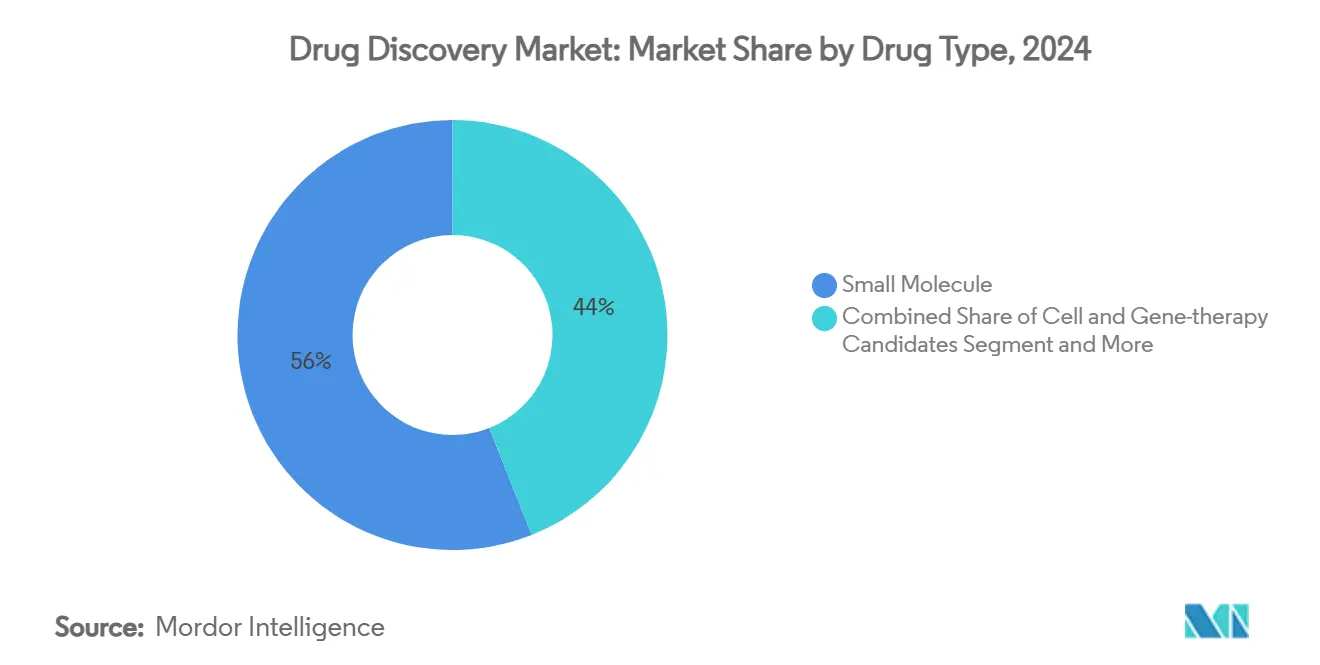
Note: Segment shares of all individual segments available upon report purchase
By Technology: AI Platforms Revolutionize Discovery Efficiency
AI-driven CADD grows at a 13.2% CAGR, underpinned by transformer models capable of generating novel chemical entities with optimized ADMET properties[3]Nature, “Innovation Powered by Digital and Data,” nature.com. Predictive algorithms evaluate millions of variants in silico, reducing reliance on brute-force screening and trimming cycles in medicinal chemistry. In contrast, high-throughput screening retains the largest share at 32% of the drug discovery market size by leveraging massive compound libraries and established robotics. Integration, not substitution, is the prevailing trend: teams use AI to triage libraries, then deploy HTS on refined subsets, combining computational insight with empirical validation to maximize hit quality.
Pharmacogenomics gains traction by linking genetic variants to drug response, enhancing trial design and post-marketing safety. DNA-encoded libraries offer combinatorial reach while enabling affinity-based selection, complementing AI chemistries. Nanotechnology introduces carrier systems that improve solubility and tissue penetration, broadening target space. Companies that orchestrate these technologies through unified data environments gain speed, accuracy, and lower attrition, thereby enlarging the drug discovery market share of integrated platforms.
By Process Workflow: Hit-to-Lead Optimization Gains Strategic Priority
Hit-to-lead and lead optimization advance at an 11.5% CAGR as firms recognize the high downstream pay-off of quality early-stage chemistry. AI-driven multi-objective optimization balances potency, selectivity, and manufacturability, producing candidates with superior clinical prospects. Target identification still dominates with 29% of drug discovery market share because genomics and proteomics continue to reveal novel biological mechanisms. Validation steps increasingly use AI-guided models to confirm disease relevance, while candidate selection incorporates predictive toxicology to avoid late failures. Pre-clinical testing is evolving toward organ-on-a-chip systems that mirror human physiology, enhancing translational accuracy. These iterative feedback loops shorten learning cycles and raise overall productivity of the drug discovery market.
By Therapeutic Area: Neurology Emerges as High-Growth Frontier
Neurology projects are expanding at a 10.6% CAGR, reflecting breakthroughs in synaptic biology and neuro-immune modulation. Programs targeting migraine, essential tremor, and Parkinson’s disease illustrate the diversification of neurological focus beyond Alzheimer’s. AI models mine multimodal datasets to uncover hidden target-disease links, improving hit rates against complex CNS biology. Oncology remains the largest segment, representing 41% of drug discovery market size in 2024, propelled by antibody-drug conjugates and immune checkpoint innovations. Cardiovascular, infectious disease, and metabolic programs are benefiting from modality cross-fertilization, such as mRNA vaccines repurposed for cytomegalovirus and obesity. The therapeutic portfolio is broadening, supporting sustained expansion of the drug discovery market.
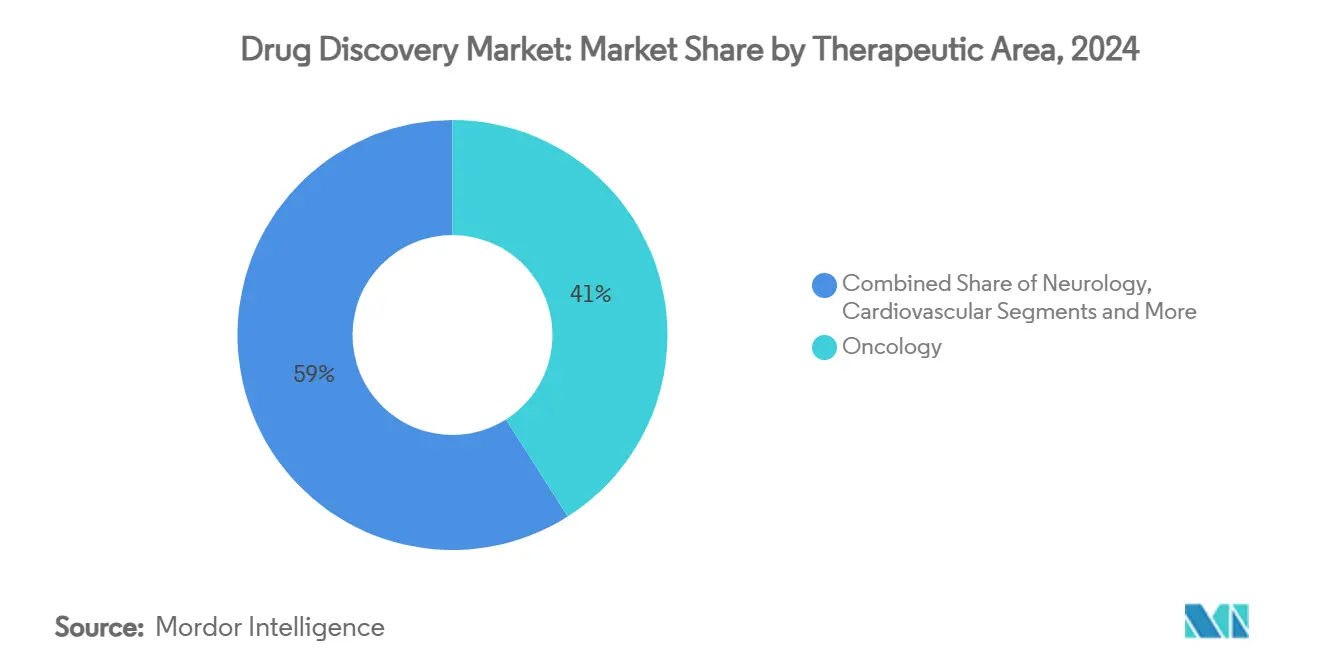
Note: Segment shares of all individual segments available upon report purchase
By End User: Biotechnology Firms Drive Innovation Velocity
Biotechnology firms post an 11.9% CAGR, buoyed by USD 26.0 billion in venture funding during 2024 and flexible R&D structures that quickly incorporate frontier technologies. Their asset-centric models align capital with discrete technical milestones, attracting specialized investors. Pharmaceutical companies retain 48% of drug discovery market size through scale, commercial reach, and manufacturing depth, yet increasingly engage in hybrid innovation via acquisitions and option-to-license partnerships. Academic institutes supply foundational science and early targets, with translational alliances accelerating bench-to-clinic progression. Convergence among these end-user categories fosters a collaborative ecosystem and underpins enduring growth of the drug discovery market.
Geography Analysis
North America led with 35% of the drug discovery market size in 2024, supported by deep research infrastructure, abundant capital, and seven FDA approvals for advanced therapies in the same year. Venture funding resilience and policy frameworks such as the Rare Disease Innovation Hub sustain momentum. However, average per-drug costs rising to USD 2.23 billion challenge smaller enterprises, spurring adoption of AI-enabled efficiency tools and encouraging cross-border outsourcing of selected functions.
Asia-Pacific is the fastest-growing region, poised for a 10.8% CAGR through 2030. Governments in China, South Korea, and Japan promote AI-rich innovation clusters, streamline trial regulations, and subsidize infrastructure. China alone contributes 23% of global pipeline candidates, reflecting the region’s mounting scientific capacity and large patient pools. Antibody-drug conjugate research flourishes, and clinical trial outsourcing benefits from cost-effective operations, reinforcing the region’s contribution to the expanding drug discovery market.
Europe maintains a robust scientific base, leveraging Horizon Europe funding mechanisms and pan-EU initiatives aiming to harmonize regulatory review. Focus areas include rare diseases and advanced therapies, with academic-industry consortia accelerating translation. The Middle East & Africa build targeted capabilities in diseases of regional prevalence, supported by sovereign-wealth investment in life-science parks. South America emphasizes natural-product discovery, benefiting from its biodiversity and the NIH’s 500,000-sample natural-product library. Cross-regional collaboration intensifies, enabling access to diverse expertise, reducing single-market risk, and collectively enlarging the drug discovery market.
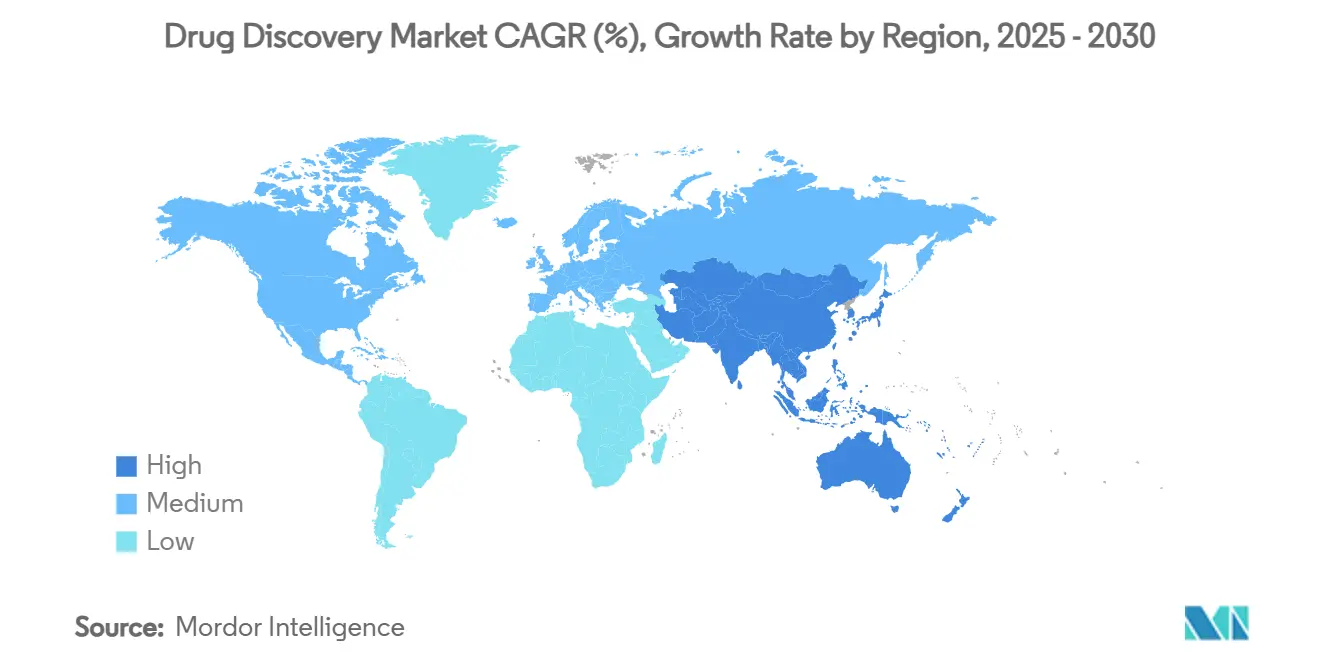
Competitive Landscape
Consolidation is reshaping competition: Johnson & Johnson’s USD 14.6 billion acquisition of Intra-Cellular Therapies, Eli Lilly’s USD 2.5 billion purchase of Scorpion Therapeutics, and GSK’s USD 1 billion deal for IDRx expand late-stage pipelines and shore up post-2028 revenue. AI-first biotechs demonstrate superior R&D productivity, integrating machine learning across target identification, molecular design, and lead optimization, challenging incumbents through speed and lower capital intensity. Large pharmaceutical companies respond by forging codevelopment alliances and investing in proprietary data lakes to retain competitive parity.
White-space innovation sits at the intersection of modality and disease biology. Applying cell and gene therapies to cardiometabolic disorders and harnessing AI to drug intrinsically disordered proteins exemplify growth frontiers. Bristol Myers Squibb’s predictive molecule invention platform highlights the strategic value of proprietary algorithms, claiming improved physicochemical properties over standard design approaches. Market entry barriers shift from scale to data quality and computational sophistication, redefining success factors in the drug discovery market.
In parallel, contract research organizations upscale digital capabilities, offering integrated AI-powered services that appeal to resource-constrained biotechs. This service-layer expansion intensifies price-value competition but also broadens access to cutting-edge discovery platforms, supporting the overall drug discovery market expansion.
Drug Discovery Industry Leaders
-
Eli Lilly and Company
-
Bristol-Myers Squibb Company
-
Novartis AG
-
Bayer AG
-
AbbVie Inc.
- *Disclaimer: Major Players sorted in no particular order
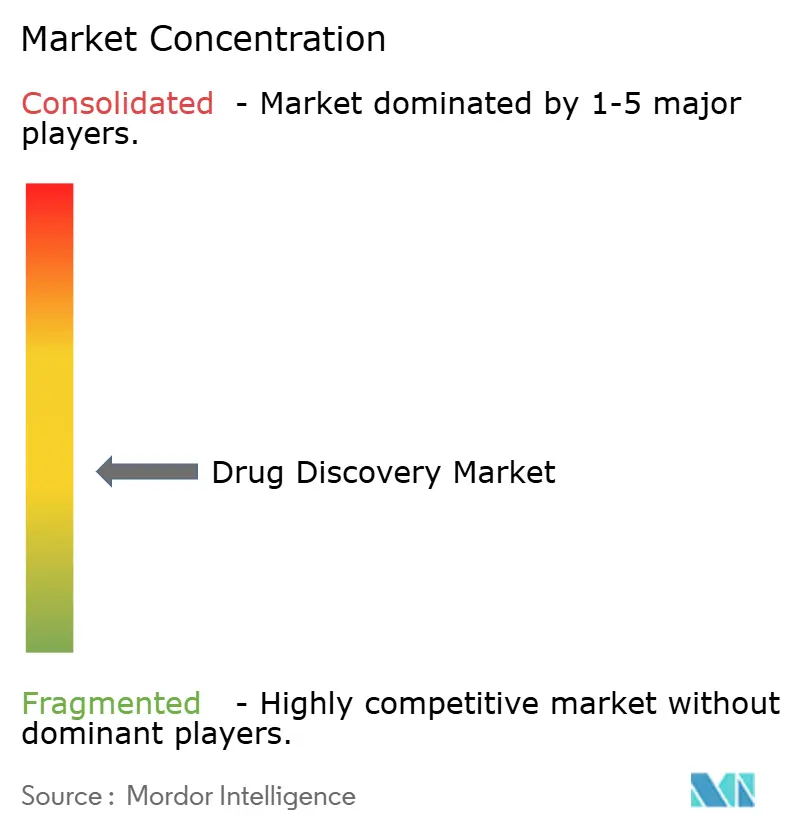
Recent Industry Developments
- April 2025: Mount Sinai launched the AI Small Molecule Drug Discovery Center to fast-track molecule design against oncology and neurodegenerative targets.
- January 2025: Johnson & Johnson acquired Intra-Cellular Therapies for USD 14.6 billion, fortifying its neuroscience franchise with Caplyta and pipeline assets.
Global Drug Discovery Market Report Scope
As per the scope of the report, drug discovery is a process aimed at identifying a compound that is therapeutically useful in treating and curing diseases. Typically, a drug discovery effort addresses a biological target that has been shown to play a role in the development of the disease or starts from a molecule with interesting biological activities. In the recent past, drug discovery has evolved significantly with emerging technologies, helping the process become more refined, accurate, and time-consuming.
The drug discovery market is segmented by drug type (small molecule drugs and biologic drugs), technology (high throughput screening, pharmacogenomics, combi natorial chemistry, nanotechnology, and other technologies), end user (pharmaceutical companies, contract research organizations (CROs), and other end users), and geography (North America, Europe, Asia-Pacific, Middle East and Africa, and South America). The report offers market forecasts and revenues in terms of value in USD million for the above segments.
| Small Molecule |
| Biologic |
| Cell & Gene-therapy Candidates |
| Peptide & Oligonucleotide Drugs |
| High-Throughput Screening (HTS) |
| Computer-Aided Drug Design (CADD) & AI Platforms |
| Pharmacogenomics |
| Combinatorial Chemistry |
| DNA-Encoded Libraries |
| Nanotechnology-enabled Discovery |
| Target Identification |
| Target Validation |
| Hit-to-Lead & Lead Optimisation |
| Candidate Selection |
| Pre-clinical Testing |
| Oncology |
| Neurology |
| Cardiovascular |
| Infectious Diseases |
| Metabolic Disorders |
| Others |
| Pharmaceutical Companies |
| Biotechnology Firms |
| Contract Research Organisations (CROs) |
| Academic & Research Institutes |
| North America | United States |
| Canada | |
| Mexico | |
| Europe | Germany |
| United Kingdom | |
| France | |
| Italy | |
| Spain | |
| Rest of Europe | |
| Asia-Pacific | China |
| Japan | |
| India | |
| South Korea | |
| Australia | |
| Rest of Asia-Pacific | |
| Middle East and Africa | GCC |
| South Africa | |
| Rest of Middle East and Africa | |
| South America | Brazil |
| Argentina | |
| Rest of South America |
| By Drug Type | Small Molecule | |
| Biologic | ||
| Cell & Gene-therapy Candidates | ||
| Peptide & Oligonucleotide Drugs | ||
| By Technology | High-Throughput Screening (HTS) | |
| Computer-Aided Drug Design (CADD) & AI Platforms | ||
| Pharmacogenomics | ||
| Combinatorial Chemistry | ||
| DNA-Encoded Libraries | ||
| Nanotechnology-enabled Discovery | ||
| By Process Workflow | Target Identification | |
| Target Validation | ||
| Hit-to-Lead & Lead Optimisation | ||
| Candidate Selection | ||
| Pre-clinical Testing | ||
| By Therapeutic Area | Oncology | |
| Neurology | ||
| Cardiovascular | ||
| Infectious Diseases | ||
| Metabolic Disorders | ||
| Others | ||
| By End User | Pharmaceutical Companies | |
| Biotechnology Firms | ||
| Contract Research Organisations (CROs) | ||
| Academic & Research Institutes | ||
| Geography | North America | United States |
| Canada | ||
| Mexico | ||
| Europe | Germany | |
| United Kingdom | ||
| France | ||
| Italy | ||
| Spain | ||
| Rest of Europe | ||
| Asia-Pacific | China | |
| Japan | ||
| India | ||
| South Korea | ||
| Australia | ||
| Rest of Asia-Pacific | ||
| Middle East and Africa | GCC | |
| South Africa | ||
| Rest of Middle East and Africa | ||
| South America | Brazil | |
| Argentina | ||
| Rest of South America | ||
Key Questions Answered in the Report
What is the current size of the drug discovery market?
The drug discovery market size is USD 106.70 billion in 2025 and is projected to reach USD 146.80 billion by 2030 at a 6.59% CAGR.
Which region is growing fastest in drug discovery?
Asia-Pacific is the fastest-growing region, expected to post a 10.8% CAGR between 2025 and 2030 due to supportive policies and rapid technology uptake.
How are AI platforms changing drug discovery economics?
AI-driven CADD platforms can shorten pre-clinical timelines by up to four years and slash industry-wide discovery costs by USD 26 billion.
Which therapeutic area commands the largest share of drug discovery pipelines?
Oncology leads with 41% of global pipelines, reflecting high unmet need and robust investment in modalities like antibody-drug conjugates.
Why are cell and gene therapies important for future growth?
Cell and gene therapies grow at a 12.8% CAGR, offering curative potential for previously untreatable diseases, and are forecast to secure multiple approvals annually.
Page last updated on:
